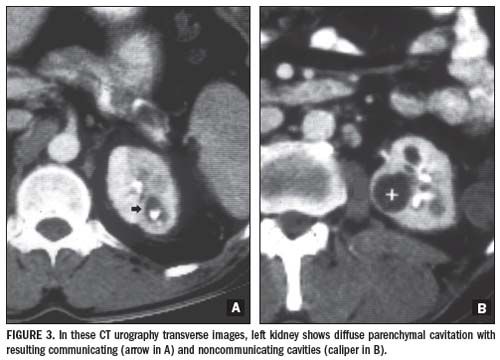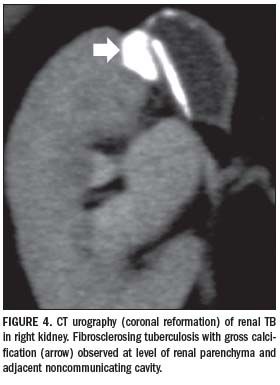Multislice CT urography characterizes renal TB
Genitourinary tuberculosis is the most common manifestation of extrapulmonary TB, accounting for 15% to 20% of infections outside the lungs.
Genitourinary tuberculosis is the most common manifestation of extrapulmonary TB, accounting for 15% to 20% of infections outside the lungs.1-3 Approximately 4% to 8% of patients with pulmonary TB will develop a clinically significant genitourinary infection.3
Mycobacterium tuberculosis reaches the genitourinary organs, particularly the kidneys, via hematogenous seeding from disease in the lungs. This seeding of the bacterium, which occurs in the periglomerular and peritubular capillary bed, takes place at the time of the initial lung infection. Small granulomas form bilaterally in the renal cortex, adjacent to the glomeruli, and remain stable for many years.4 A high rate of perfusion and favorable oxygen arterial concentration increase the likelihood of bacilli proliferating in this location.
The disease remains confined to the renal cortex in patients whose cellular immunity is intact. The breakdown of host defense mechanisms in some patients leads to the reactivation of cortical granulomas, resulting in enlargement and coalescence. Organisms spread into the renal medulla causing papillitis, which may extend into the collecting system.4 Capillary rupture allows the organisms to migrate to the proximal tubule and loop of Henle, leading eventually to the development of enlarging, caseating granulomas and papillary necrosis.
Granuloma formation, caseous necrosis, and cavitation are stages of progressive infection, which can eventually cause the loss of renal function and calcification of the entire kidney (autonephrectomy). The renal disease remains quiescent until there is an insult to the host’s immunity at which time reactivation occurs.
Patients with genitourinary TB typically have local symptoms, including frequent voiding and dysuria. Hematuria can be either microscopic or macroscopic. Symptoms may also include back, flank, or abdominal pain.3,5 Constitutional symptoms, such as fever, weight loss, fatigue, and anorexia, are less common.3,5
Laboratory abnormalities include pyuria, proteinuria, and hematuria. Standard urine cultures can be normal. The presence of routine urinary tract pathogens can also delay the diagnosis of coexistent TB.3 M. tuberculosis is isolated from the urine in 80% to 95% of patients with genitourinary TB. Renal TB is the best known etiology of infundibular strictures in adults with consequent hydrocalyx. Obstruction may develop early or during the healing phase, even while the patient is receiving antituberculosis therapy.
Each finding of renal TB can be caused by other diseases. This is why renal TB is often called “the great imitator.” But the coexistence of multiple abnormalities usually allows the condition to be diagnosed correctly.
The kidney may appear large, normal-sized, or small on plain-film radiography and unenhanced CT. Clinically significant disease is usually limited to one side. Despite hematogenous seeding of both kidneys, approximately 75% of renal tuberculous involvement is unilateral.
The appearance of renal tuberculosis on gray-scale ultrasound is not specific. Contrast ultrasound is advised for the evaluation of nonfunctioning kidneys and for follow-up during antituberculosis therapy. As with CT, the kidney may appear large, normal-sized, or small, and calcifications are common. Hydronephrosis or hypoechoic parenchymal lesions, corresponding to parenchymal abscesses due to caseating necrosis, may be observed.
CT FOR ASSESSMENT
CT urography is now regarded as the correct imaging technique for upper urinary tract assessment, including its involvement in renal TB. Multislice CT has made it possible to collect thin (submillimeter) collimated data of the entire urinary tract during a single short breath-hold. The dedicated multiphasic scanning technique, which involves injection of intravascular contrast, generates high-resolution images of the renal parenchyma and urinary tract, including the bladder.6 All clinical indications previously addressed by intravenous excretory urography are now covered by MSCT urography.
CT urography typically consists of a multiphasic spiral CT protocol. A preliminary unenhanced CT scan is performed from the upper pole of the kidney to the lower edge of the symphysis pubis to detect calculi, reveal the unenhanced appearance of masses throughout the urinary tract, and provide a baseline value of attenuation for masses and other abnormalities. Unenhanced images can also be used to evaluate the presence of fat and/or calcium in masses.
The number of CT urography phases in the single-bolus technique generally varies between two and four. These typically include:
• an unenhanced phase of the abdomen and pelvis;
• a nephrographic phase of the kidney; and
• an excretory phase of the abdomen and pelvis.
Information from the arterial phase is not needed routinely, so only a few groups use a corticomedullary phase. Some groups extend the nephrographic phase to the pelvis, especially when the patient is at increased risk of malignancy. This extension allows complete tumor staging or the evaluation of associated findings. The number of phases should be kept to a minimum, given the high dose of radiation associated with CT urography.

Three-D images are created interactively on a 3D workstation after the examination. Thin-slab volume rendering, average-intensity projections (AIP), or maximum-intensity projections (MIP) can be used for interactive image evaluation.
We use a “split-bolus” technique for our CT urography examinations. This technique avoids the need for separate nephrographic and excretory phase scans, reducing the total number of scans from three to two, and thus reducing the patient’s radiation exposure.7
The split-bolus technique employs a synchronous nephrographic and pyelographic excretory phase.8,9 Once the patient is positioned on the table, furosemide is administered intravenously (0.1 mg/kg), and an unenhanced scan is acquired from the upper pole of the kidneys to the bladder base. The contrast agent is then injected in two boluses (400 mgI/kg then 200 mgI/kg), separated by a six-minute delay and a saline flush. A second scan of the entire abdomen and pelvis is acquired after injection of the second bolus. This provides both an effective nephrographic phase image (thanks to the second bolus) and good opacification and distension of the urinary tract (thanks to the time delay after the first bolus).
The advantage of split-bolus contrast administration is that a combined nephropyelographic phase is acquired instead of two separate phases, with relatively reduced radiation exposure. Further dose optimization is achieved through the use of low-dose protocols and tube current modulation.

One drawback of the split-bolus technique is that the reduced level of contrast means the ureters and bladder are not imaged appropriately. There is also evidence of beam hardening artifacts in the kidney if furosemide is not administered, and the actual dose reduction is relatively limited (~15%) when compared with the standard single-bolus technique with three-phase CT urography.
IMAGING PATTERNS
CT urography provides an accurate evaluation of the amount of residual functioning parenchyma and extrarenal spread in renal TB. Early manifestations of renal TB seen on CT urography include calyceal erosion (“moth-eaten calyx”) with progression toward medullary (Figure 1) or papillary necrosis, and infundibular stricture with or without hydrocalyx. Single or multiple calices may be involved in one or both kidneys.4
The pathologic features of renal TB are extremely different and different features often coexist. Common sites of tuberculous strictures include the calyceal neck with hydrocalyx (Figure 2) or “phantom calyx,” infundibulum of a calyx with hydrocalyx or regional or focal hydrocalycosis, the ureteropelvic junction with dilatation of the entire renal pelvis, calyces and infundibula, or the lower ureteral segment.
4 An infundibular stricture may produce a phantom calyx when that segment of the kidney becomes nonfunctional.4 The demonstration of parenchymal gross calcifications on CT is extremely accurate.
Renal TB may manifest as extensive cavitation (open or extensive forms) or fibrosclerosis (closed forms).9-11 The open or extensive form (Figure 3) corresponds to the extension of caseified tissue necrosis to the intrarenal excretory tract. Parenchymal masses, which may be calcified, can also develop.4


Communication of granulomas with the collecting system can lead to regional spread of the bacilli into the renal pelvis, ureters, urinary bladder, and accessory genital organs. Extensive cavitation may determine renal caseation, whereas a fibrosing reaction of the urinary tract results in obstructive hydronephrosis. The disease can evolve in three ways when the process spreads into the collecting system:
• extensive cavitation (Figure 3);
• fibrosclerosis with resulting non-communicating cavities; and
• recurrent 'poussées.'
The closed or fibrosclerotic form (Figure 4), consisting of the extension of caseified necrosis toward the renal parenchyma, has a better outcome after therapy. The host’s healing response induces fibrosis with calcium deposition, focal fibrosis with progressive parenchymal scarring, stricture formation, dilatation of the intrarenal urinary tract, and autonephrectomy (no functional contrast excretion).

Fibrosclerotic forms of renal TB may appear as:
• pure fibrosclerosis with parenchymal scarring, often with evidence of noncommunicating cavities (Figure 4);
• reactivation of the granulomatous process over a permanent status of fibrosclerosis with caseous necrosis and cavitation; and
• a mixture of the fibrosclerotic and cavitating forms, with cavities that are communicating or noncommunicating with the intrarenal urinary tract.
Calcifications within the renal parenchyma are common, occurring in 37% to 71% of cases (Figure 4), and follow different patterns.3 They may be amorphous, granular, lobar, or curvilinear, and frequently extend beyond the kidney (e.g., to the psoas muscle).
The end stage of renal TB corresponds to extensive renal parenchyma caseation and cavitation, resulting in putty kidney (Figure 5). The entire kidney may become small, scarred, and densely calcified with autonephrectomy, and the collecting system becomes filled with calcified and thick materials.12
GE HealthCare Debuts AI-Powered Cardiac CT Device at ACC Conference
April 1st 2025Featuring enhanced low-dose image quality with motion-free images, the Revolution Vibe CT system reportedly facilitates improved diagnostic clarity for patients with conditions ranging from in-stent restenosis to atrial fibrillation.
The Reading Room Podcast: Current Perspectives on the Updated Appropriate Use Criteria for Brain PET
March 18th 2025In a new podcast, Satoshi Minoshima, M.D., Ph.D., and James Williams, Ph.D., share their insights on the recently updated appropriate use criteria for amyloid PET and tau PET in patients with mild cognitive impairment.